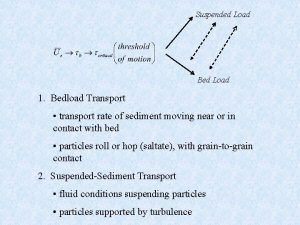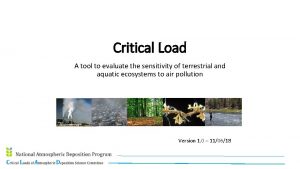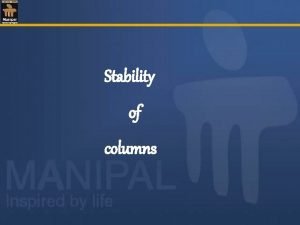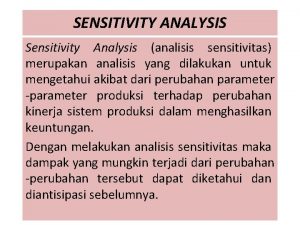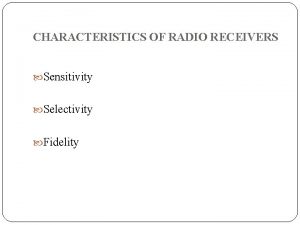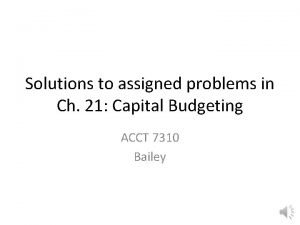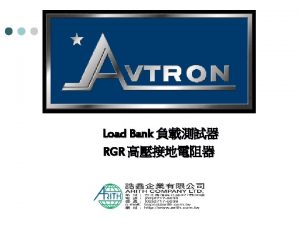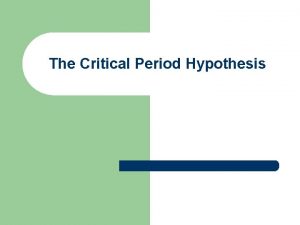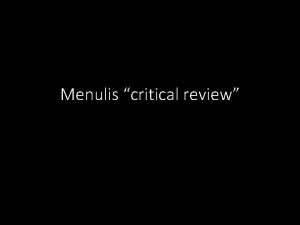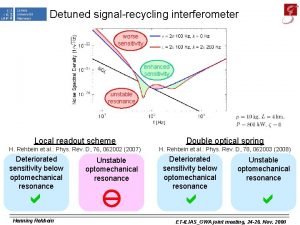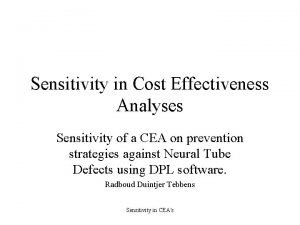Critical Load A tool to evaluate the sensitivity





























































- Slides: 61

Critical Load A tool to evaluate the sensitivity of terrestrial and aquatic ecosystems to air pollution Version 1. 0 – 11/06/18

Source and Reference for Presentation • This presentation was produced by the National Atmospheric Deposition (NADP)– Critical Loads of Atmospheric Deposition (CLAD) Science Committee Executive Team as a source of information and slides for presentations that include critical loads. • It is a product of NADP–CLAD. Any opinions, findings, conclusions, or recommendations as part of the slides and information herein do not necessarily reflect the views of CLAD, NADP, and/or respective members’ affiliations. • Please use the following as a reference for this presentation and/or individual slides from this presentation: Phelan, J. N. , Cummings, T. G. , Bell, M. D. , and Lynch, J. A. 2018. Critical Load – a tool to evaluate the sensitivity of terrestrial and aquatic ecosystems to air pollution (version 1. 0). National Atmospheric Deposition Program, Wisconsin State Lab of Hygiene, University of Wisconsin – Madison, WI.

Critical Load Presentation Information and Guidance • This set of slides is meant to be a living document that serves as a resource for individuals making presentations related to critical loads of atmospheric deposition. The slides provide a broad overview of critical load science varying from simple definitions to complex biogeochemical relationships. The intent of including all of the information in the same format, is that when users pull from the presentation based on their needs (i. e. , the user can use all or only some of the slides, based on their needs), the messaging will remain consistent across audiences. As the use of critical loads in a policy context has not been codified among agencies, this topic was intentionally left vague, with the expectation that a user will develop their own management or policy slides, based on their agency or organization priorities. • If you add content/information (and would like to contribute to this presentation), please use the following points as guidance: • If you add information, specific examples, etc. , please add your name and date beside each note in the notes field of the slide. • If you add a new slide, please add your name and date in the notes field of the new slide. • If you make additions to a slide, please describe the additions in the notes field (along with your name and date). • Please send inquiries, comments, and changes to the presentation to NADP–CLAD Program Manager – Jennifer Phelan (Jennifer. Phelan@slh. wisc. edu)

Abbreviations in Presentation Al – aluminum ARP – Acid Rain Program (U. S. EPA) BLM – U. S. Bureau of Land Management C – carbon CL – critical load CLAD – Critical Loads of Atmospheric Deposition Science Committee of NADP CSPAR – Cross-State Air Pollution Rule EPA – U. S. Environmental Protection Agency FWS – U. S. Fish and Wildlife Service H 2 SO 3 – sulfurous acid H 2 SO 4 – sulfuric acid HNO 3 – nitric acid N – nitrogen NADP – National Atmospheric Deposition Program NCLD – National Critical Load Dataset NH 3 – ammonia NH 4+ – ammonium NO 3 - – nitrate NPS – U. S. National Park Service NOx – oxides of nitrogen NYSERDA – New York Energy Research and Development Authority PM – particulate matter S – sulfur SO 2 – sulfur dioxide SO 42 - – sulfate SOx – oxides of sulfur TDEP – Total Deposition (deposition dataset) TNC – The Nature Conservancy USFS – U. S. Forest Service WSU – Washington State University

Nitrogen (N) and Sulfur (S) Air Pollution http: //www. mrgscience. com/esstopic-63 -photochemicalsmog. html

Nitrogen (N) Species • Inorganic N: • Oxides of N (NOx) • • Industrial and vehicle sources (combustion of fossil fuels) Lightning Precursor to ozone and particulate matter (PM) Forms nitric acid (HNO 3) in atmosphere; component of acid rain • • Predominantly agricultural sources (application of fertilizers) Also from mobile sources with catalytic reduction Precursor to PM Becomes ammonium (NH 4+) in atmosphere (in precipitation) • Ammonia (NH 3) • Organic N • Can be a significant contribution, but is less understood

Annual Oxides of N (NOx) Emissions from CSAPR and ARP Sources, 1990 -2015 https: //www 3. epa. gov/airmar kets/progress/reports/emissio ns_reductions_nox. html

Sulfur (S) Species • Oxides of S (SOx) • Industrial sources; mainly combustion of coal and oil • Forms sulfurous acid (H 2 SO 3) and sulfuric acid (H 2 SO 4) in the atmosphere; components of acid rain • Precursor to PM

Oxides of S (SO 2) Emissions from CSAPR and ARP Sources, 1980 -2015 https: //www 3. epa. gov/airmark ets/progress/reports/emissions _reductions_so 2. html#figure 1

Why do we care? • Air pollution deposits to ecosystems in the form of wet and dry N and S deposition

N and S Pollution Transport and Fate https: //nature. nps. gov/air/Studi es/critical. Loads/Dep. Explain. cfm

Nitrogen (N) Deposition – TDEP (2013 -2015) NOy NHx Total N ftp: //ftp. epa. gov/castnet/tdep/images/

Sulfur (S) Deposition – TDEP (2013 -2015) ftp: //ftp. epa. gov/castnet/tdep/images/

Why do we care? • Air pollution deposits to ecosystems in the form of wet and dry N and S deposition • N and/or S deposition negatively impact the biota in terrestrial and aquatic ecosystems and the services they provide

How do N and S deposition negatively impact ecosystems? • Eutrophication – excess N: • Fertilizing effect in soils and drainage/surface waters (lakes, streams, and estuaries) • Acidification – excess S and/or N: • Acidifies soils and drainage/surface waters

Eutrophication – excess N • Fertilizing effect: • Terrestrial and aquatic mechanisms: • N is the limiting nutrient to growth in many terrestrial and aquatic ecosystems • Excess N stimulates growth in many ecosystems • Excess N changes competitive interactions and advantage, leading to changes in composition and diversity • Increased nitrate (NO 3 -) leaching to drainage/surface waters

Acidification – excess N and/or S • Acidifies soils and drainage/surface waters: • Terrestrial mechanisms: • Increased aluminum (Al) in soil solution; Al is toxic to many plant species • Leaching of base cations from rooting zone of soil; loss of nutrients and creation of nutrient imbalance • Species of plants, trees, mycorrhizae, and lichens differ in their sensitivity to these conditions • Aquatic mechanisms: • Leaching of sulfate (SO 42 -) and NO 3 - leading to export of base cations and decreased p. H and ANC in drainage/surface waters • Increased Al in drainage/surface waters; Al is toxic to many aquatic species • Species of aquatic macroinvertebrates, algae, and fish differ in their sensitivity to these conditions

How is N and/or S deposition negatively impacting your system? • Eutrophication OR Acidification? *** mechanism is often not certain because N can act as a fertilizer and acidifying agent, and N and S deposition are often correlated; both mechanisms can be occurring in an ecosystem***

Ecosystem Effects of N Deposition • Annual Plants: • • • Increased or decreased primary productivity Increased mortality Changes in community composition Loss of biodiversity Spread of invasive species Invasive grass (Schismus spp. )in Sonoran Desert (Photo: E. Allen)

Ecosystem Effects of N Deposition • Lichens: • • Changes in community composition Increases in nitrophilic/eutrophic species Loss of biodiversity Extirpation Wolf lichen

Ecosystem Effects of N Deposition • Forests: • • • Loss of mycorrhizae Increased and decreased tree growth Increased mortality of trees Changes in forest composition Loss of biodiversity Tiarella cordifolia Eastern hemlock Ectomycorrhizae Ponderosa pine Red elm

Ecosystem Effects of N Deposition • Drainage/Surface waters: • • Increased algal and/or cyanobacterial growth Decline in diatom diversity Changes in composition of aquatic biota Together with other sources of nitrogen can lead to algal bloom Gyrosigma acuminatum (diatom)

Ecosystem Effects of Acidifying N and S Deposition • Terrestrial Ecosystems: • • • Decreased tree growth Increased mortality of trees Decreased survival of seedlings Changes in forest composition Loss of biodiversity Yellow birch Sugar maple Red spruce

Ecosystem Effects of Acidifying N and S Deposition • Drainage/Surface waters: • Loss of aquatic biodiversity • Reduced population health, reproduction capacity, and fitness • Loss of fish, macroinvertebrate, and amphibians from streams/lakes

So, how much deposition is too much? Critical Load A quantitative estimate of exposure to one or more pollutants below which significant harmful effects on specified sensitive elements of the environment do not occur according to present knowledge (Nilsson and Grennfelt 1988; UBA, 2004). https: //www. srs. fs. usda. gov/airqualityp ortal/critical_loads/cls_background. php

Component Deposition either: s of a • directly impacts biota, or • changes soil or water chemistry that impacts biota Critical Changes to soil or water chemistry exceed a threshold amount beyond Load which biota (biological receptor) is negatively impacted Change in biological receptor (biological response) exceeds a threshold amount

Critical Load • Critical load values differ and reflect different sensitivities of different biological indicators to deposition • Biological receptors can have a range of critical load values; sensitivities can vary by location Sensitivity • Critical loads are defined for specific biological indicators, receptors, or endpoints Change in lichen species composition Forest ecosystem critical loads Change in herb diversity CL = 1. 5 -12. 7 kg N/ha/yr CL = 3 -39 kg N/ha/yr CL = 7. 9 -19. 6 kg N/ha/yr N deposition (kg/ha/yr)

Change in algal diatom species composition Change in macroinvertebrate community • Critical loads are defined for specific biological indicators, receptors, or endpoints • Critical load values differ and reflect different sensitivities of different biological indicators to deposition • Biological receptors can have a range of critical load values; sensitivities can vary by location Sensitivity Critical Load Reduction in sensitive fish species Reduction in non-sensitive fish species e. g. , Blacknose dace e. g. , brook trout Change in Water Quality with increasing N and S deposition (kg/ha/yr)

How are critical loads determined? • Empirical critical load: • involves observed spatial or temporal gradient studies or experimental manipulations of pollutants • applied to sites or landscapes that are ecologically comparable to location(s) from which critical loads were determined • Steady-state mass balance critical load: • derived from mathematical mass-balance models under assumed or modeled equilibrium conditions • models vary in complexity with regard to process representation

Examples of Critical Load maps Aquatic Acidification (by location) Aquatic Acidification – 10 th quartile (aggregated by 12 -km grid cells) http: //nadp. sws. uiuc. edu/committees/clad/db/NCLDMap. Summary_2016. pdf

Examples of Critical Load maps http: //nadp. sws. uiuc. edu/committee s/clad/db/NCLDMap. Summary_2016. pdf

What happens if deposition is greater than a critical load? Critical Load Exceedance The critical load is exceeded if the deposition load of a pollutant is greater than or equal to the critical load of the pollutant for the same location. The source of the deposition In mathematical terms, the load estimate is defined by exceedance (Ex) of the critical the user. load CL(X) is given as: Ex(Xdep) = Xdep – CL(X)

Examples of Critical Load Exceedance maps

Critical Load Exceedance Sensitivity Change in Biological Receptor A Critical Loads for A and B are exceeded A Change in Biological Receptor B CL = 0. 3 kg N/ha/yr B CL = 0. 5 -1. 0 kg N/ha/yr Change in Biological Receptor C C Change in Biological Receptor D CL = 2 -3 kg N/ha/yr D CL = 5 -10 kg N/ha/yr N deposition (kg/ha/yr)

What happens when a critical load is exceeded? • Biological indicator is negatively impacted • Biological responses: • • • Increased or decreased growth Decreased survival Loss of species Reduced biodiversity Change in species composition Disruptions in food web dynamics • Response may not occur immediately

How are critical loads used? • State agencies – • risk assessment and policy development (e. g. , NYSERDA) • Federal agencies – • in support of natural resource/land management (e. g. , NPS, USFS, BLM, and FWS) • policy and pollution standard development and review (e. g. , EPA) • Non-Governmental Organizations – • assessment tool (e. g. , The Nature Conservancy)

Critical Load Tools and Resources • EPA Critical Loads Mapper Tool • US Forest Service Air Quality Portal for Land Management Planning • USFS N-CLAS • National Park Service • USDA Forest Service • UNECE - Modeling and Mapping • UNECE - Coordinating Center for Effects • NADP-CLAD

NADP-CLAD • Critical Loads of Atmospheric Deposition (CLAD) Science Committee of the National Atmospheric Deposition Program (NADP) in the U. S • Established in 2010 • Multi-agency group consisting of federal and state government agencies, non-governmental organizations, environmental research organizations, and universities. • Goals: • facilitate sharing of technical information on critical loads topics within a broad multi -agency/entity audience • fill gaps in critical loads development in the U. S. • provide consistency in development and use of critical loads in the U. S. • promote understanding of critical loads approaches through development of outreach and communications materials • http: //nadp. sws. uiuc. edu/committees/clad/

NADP-CLAD - Products • National Critical Load Database (NCLD) • Developed and updated using published research (and data) produced by CLAD members and other scientists in the U. S. • Critical Load Types within NCLD: • Terrestrial Forest Soil Acidification • Aquatic Surface/Drainage Water Acidification • Empirical Critical Load of Nitrogen: • • • Forest ecosystems Herbaceous species and shrubs Herbaceous biodiversity Mycorrhizal fungi Lichens Nitrate Leaching • Critical Load Maps

References Cited • Nilsson, J. and P. Grennfelt. 1988. Critical loads for sulphur and nitrogen. Report from a workshop held at Skokloster, Sweden 19 -24 March 1988. Miljorapport 15, 1 -418. • UBA (Umwelt. Bundes. Amt). 2004. Manual on methodologies and criteria for mapping critical levels/loads and geographical areas where they are exceeded. Federal Environmental Agency (Umwelt. Bundes. Amt), Berlin, Germany. http: //www. rivm. nl/en/themasites/icpmm/manual-anddownloads/manual-english/index. html.

Acknowledgements • Presentation was developed by NADP-CLAD Executive Team (Jennifer Phelan, Tonnie Cummings, Jason Lynch, and Michael Bell) • Slides and/or content were contributed by Tamara Blett (NPS), Linda Pardo (USFS), Linda Geiser (USFS), Ellen Porter (NPS), and Rebecca Evans (WSU) • Sources of data and figures are acknowledge on slides • Cited references are listed in the References cited slide


EXTRA SLIDES / LIBRARY OF ADDITIONAL CL SLIDES • The following slides are extra slides from different CL presentations that are not to include in the slide deck for the CLAD CL presentation, but may be useful for your presentation needs • Note: these slides have been copied and pasted from their source (and therefore may not be consistent in style, format or content with main presentation slides)

Target Load Forest decline (acidification effects on trees) H Lethal effects on fish, other aquatic animals (chronic acidification) G Effects on aquatic animals (episodic acidification) F Change in alpine plant species E Changes in tree chemistry D Surface water N saturation C Change in aquatic plant species composition Changes in soil & water chemistry H G F E D C B A Target Load Current deposition level N Load (kg/ ha /yr)

Critical Loads for U. S. Ecosystems • From NADP-CLAD National Critical Load Database (NCLD) v 3. 0

Target Load Definition • The deposition load that is selected or determined to provide a level of protection for or recovery of sensitive ecosystem components based on time frame for resource protection, feasibility of emissions reductions, and/or other considerations. Target loads can be determined through management or policy considerations, or by using dynamic process-based models that calculate the deposition load that leads to a desired chemical or biological state of an ecosystem in a given future year (Posch et al. 2003). The target load may be set higher or lower than or equal to the critical load. Target load has sometimes been referred to as “dynamic critical load. ”

Critical Loads and Target Loads • A critical load is based on studies or modeling and is the amount of pollution below which harmful environmental effects are not expected to occur. (Science -based) • A target load identifies an acceptable amount of pollution and is based on policy, economic, temporal, or other considerations. A target load may be higher or lower than a critical load. (Management decision)

Current N deposition in Rocky Mountain NP Aquatic Ecosystem Critical Load Natural background N deposition N Load (kg/ ha /yr)- wet Rocky Park: Continuum Impacts to Ecological Health Rocky. Mountain National Park: of of Impacts to Ecological Health 3. 1 kg/ha/y r 1. 5 kg/ha/y r “weight of evidence” of ecosystem health decline on east side of park 0. 2 kg/ha/y r Changes in soil & water chemistry Surface water N saturation Change in aquatic plant species composition Changes in tree chemistry Effects on aquatic animals (episodic acidification) Change in alpine plant species Forest decline (acidification effects on trees) Lethal effects on fish, other aquatic animals (chronic acidification)


Too much of a good thing

More invasion • Increased plant available N more accessible by invasive species. • Native also enhanced, but often outcompeted by invasives • Can enhance rate of invasion and allow species to invade previously undisturbed habitat

Critical Load • The threshold of deposition below which specified harmful ecological effects do not occur (Porter et al. 2005) Pollutant Load Chemical Variables Biological Responses SO 4, NH 4, NO 3, Hg, POPs, NOx, SO 2 ANC, p. H, Nitrogen, Base Saturation, Ca/Al Death of Indicator species, Decline in Condition of individuals Decreased Reproductive Success

• The term critical load is used to describe threshold of air pollution deposition that causes harm to sensitive resources in an ecosystem. • Critical loads work has focused on nitrogen (N) and sulfur (S) air pollutants that are deposited into ecosystems. • Critical loads are typically expressed in terms of kilograms per hectare per year (kg/ha/yr) of wet or total (wet + dry) deposition. • Critical loads can be developed for a variety of ecosystem responses, including shifts in microscopic aquatic species, increases in invasive grass species, changes in soil chemistry affecting tree growth, and lake and stream acidification to levels that can no longer support fish. • They can be used to assess ecosystem health, guide resource management decisions, and evaluate the effectiveness of emissions reduction strategies. Critical load definition

USDA-Forest Service Air Quality Portal (available now) • Uses a decision tree format to guide managers to identify areas with CL exceedance and determine potential mitigation activities https: //www. srs. fs. usda. gov/airqualityportal/ USDA-Forest Service N-CLAS tool (in development) • Uses a 4 -step process to identify the area of concern, select a species or community type, and make on-the-fly charts and figures of CLs and relative risks and uncertainties at current deposition levels US EPA Critical Loads Mapper (in development) • Archives the most recent deposition and critical loads estimates and allows user to map exceedances for any management unit or critical load Publically accessible tools in development

Why do we care? – original version of slide • Changes vegetation patterns • Decreases biodiversity • Can increase rates of change from shifting climate • Reduces quality of the visitor experience

Ecological Impacts of N deposition • Landscape • Synergistic effects of Climate Change / Development / Fire / Invasive Grasses (Rao et al. 2010, Talluto and Suding 2008) Exotic Species Fire Urbanization Nitrogen Deposition


Critical Load and Exceedance Maps

Critical Load and Exceedance Maps

Critical Load and Exceedance Maps

 Semi critical instruments in dentistry
Semi critical instruments in dentistry Critical semi critical and non critical instruments
Critical semi critical and non critical instruments The point of intersection of dc and ac load line
The point of intersection of dc and ac load line Bearing
Bearing Red dot
Red dot Pux
Pux Critical load
Critical load Slenderness ratio formula
Slenderness ratio formula What is critical buckling load
What is critical buckling load Wapt testing tool
Wapt testing tool Slidetodoc.com
Slidetodoc.com Axis critical appraisal tool
Axis critical appraisal tool Rambo critical appraisal tool
Rambo critical appraisal tool Potter's tool is data cleaning tool
Potter's tool is data cleaning tool Thiếu nhi thế giới liên hoan
Thiếu nhi thế giới liên hoan Phối cảnh
Phối cảnh Một số thể thơ truyền thống
Một số thể thơ truyền thống Các châu lục và đại dương trên thế giới
Các châu lục và đại dương trên thế giới Thế nào là hệ số cao nhất
Thế nào là hệ số cao nhất Lp html
Lp html Hệ hô hấp
Hệ hô hấp Số nguyên tố là
Số nguyên tố là Tư thế ngồi viết
Tư thế ngồi viết đặc điểm cơ thể của người tối cổ
đặc điểm cơ thể của người tối cổ Mật thư anh em như thể tay chân
Mật thư anh em như thể tay chân Glasgow thang điểm
Glasgow thang điểm ưu thế lai là gì
ưu thế lai là gì Thẻ vin
Thẻ vin Cái miệng nó xinh thế chỉ nói điều hay thôi
Cái miệng nó xinh thế chỉ nói điều hay thôi Các châu lục và đại dương trên thế giới
Các châu lục và đại dương trên thế giới Bổ thể
Bổ thể Từ ngữ thể hiện lòng nhân hậu
Từ ngữ thể hiện lòng nhân hậu Diễn thế sinh thái là
Diễn thế sinh thái là Tư thế ngồi viết
Tư thế ngồi viết Ví dụ về giọng cùng tên
Ví dụ về giọng cùng tên Thể thơ truyền thống
Thể thơ truyền thống 101012 bằng
101012 bằng Bài hát chúa yêu trần thế alleluia
Bài hát chúa yêu trần thế alleluia Hổ đẻ mỗi lứa mấy con
Hổ đẻ mỗi lứa mấy con đại từ thay thế
đại từ thay thế Vẽ hình chiếu vuông góc của vật thể sau
Vẽ hình chiếu vuông góc của vật thể sau Công của trọng lực
Công của trọng lực Tỉ lệ cơ thể trẻ em
Tỉ lệ cơ thể trẻ em Thế nào là mạng điện lắp đặt kiểu nổi
Thế nào là mạng điện lắp đặt kiểu nổi Hát kết hợp bộ gõ cơ thể
Hát kết hợp bộ gõ cơ thể Lời thề hippocrates
Lời thề hippocrates Vẽ hình chiếu đứng bằng cạnh của vật thể
Vẽ hình chiếu đứng bằng cạnh của vật thể Quá trình desamine hóa có thể tạo ra
Quá trình desamine hóa có thể tạo ra độ dài liên kết
độ dài liên kết Các môn thể thao bắt đầu bằng tiếng đua
Các môn thể thao bắt đầu bằng tiếng đua Sự nuôi và dạy con của hươu
Sự nuôi và dạy con của hươu Dot
Dot điện thế nghỉ
điện thế nghỉ Biện pháp chống mỏi cơ
Biện pháp chống mỏi cơ Trời xanh đây là của chúng ta thể thơ
Trời xanh đây là của chúng ta thể thơ Chó sói
Chó sói Apa itu sensitivity
Apa itu sensitivity What is shadow price in sensitivity analysis
What is shadow price in sensitivity analysis What is sensitivity and selectivity of radio receiver
What is sensitivity and selectivity of radio receiver Interest rate sensitivity analysis
Interest rate sensitivity analysis Ppv vs sensitivity
Ppv vs sensitivity Irr sensitivity analysis
Irr sensitivity analysis





